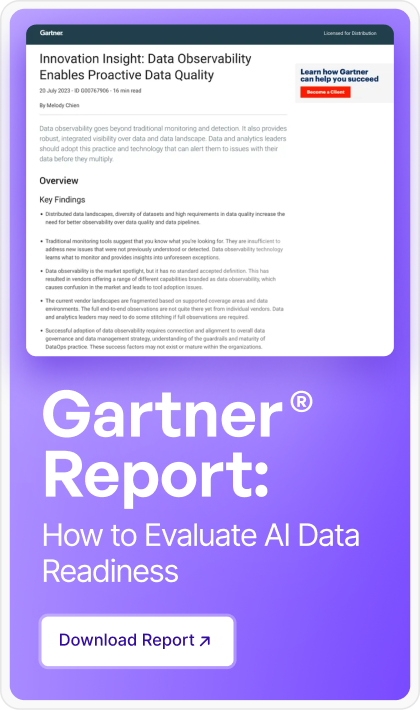Imagine you are a data analytics engineer tasked with delivering insights from the sales team's performance metrics. However, with data scattered across multiple platforms—ranging from spreadsheets and CRM systems to cloud databases—you find yourself overwhelmed.
Every time you attempt to compile a comprehensive report, you face inconsistencies in data formats, missing entries, and slow retrieval times. Your efforts to integrate this fragmented data into a cohesive analysis often result in delays, preventing the sales team from making timely, informed decisions. This is what most organizations have to deal with, the lack of a unified data platform for analytics.
According to a study by McKinsey, companies that make data-driven decisions are 23 times more likely to acquire customers and six times more likely to retain them compared to their competitors.
A unified data platform empowers engineers to deliver actionable insights swiftly, thus driving better business outcomes and fostering a data-driven culture across the organization.
What Is a Unified Data Platform?
A unified data platform is an integrated system designed to consolidate various data sources, enabling seamless data management, analytics, and insights across the organization.
A unified data platform integrates data ingestion, storage, processing, and analysis into a single, cohesive environment, unlike traditional data architecture that relies on separate tools for each function. This approach breaks down data silos, ensures data consistency, and facilitates real-time analytics by providing a comprehensive view of the data lifecycle.
Key components and features
The key components and features of a unified data platform work together to streamline the entire data lifecycle, from integration and storage to processing and visualization.
- Data integration: Unified data platform combines data from multiple sources (e.g. databases, cloud services, and applications) into a unified framework, allowing for seamless data ingestion, transformation, and analytics integration. This ensures a consistent flow of data, enabling businesses to derive insights more efficiently across the entire organization.
- Storage: The data platform for analytics provides centralized storage options, supporting both structured and unstructured data, and offers scalability for handling large data volumes, which is crucial for maintaining the consistency and accessibility of data analytics.
- Processing: A unified data platform supports batch and real-time processing to prepare data for analysis, enabling ETL (Extract, Transform, Load) pipelines and streamlining data workflows, making it an essential part of a comprehensive data platform for analytics.
- Visualization and analytics: The unified data platform includes tools for data visualization and data analytics, enabling users to create reports, dashboards, and insights directly from the platform, which supports better decision-making processes.
- Governance and security: A unified data platform offers built-in data governance features to manage data access, compliance, and data lineage, ensuring data quality and security.
Comparison with traditional data analytics infrastructure
In traditional data analytics, each function—data ingestion, storage, processing, and visualization—is often handled by separate systems. This setup leads to:
- Data silos: Data is scattered across various systems, creating difficulties in integration and consistent access.
- Manual effort: Significant manual effort is required to move data between systems, leading to delays and potential errors.
- Complexity in data management: Using different tools necessitates separate management, which raises administrative burdens and maintenance costs.
Challenges in Data Analytics: Addressing the Need for Unified Platform
Organizations that lack a unified data platform often face significant hurdles in managing their data effectively. The following challenges impact data quality, governance, and the ability to make informed business decisions.
1. Data silos and fragmented data sources
Data stored across multiple systems or departments creates silos that impede a comprehensive view of the information. Different teams may use various tools or databases, resulting in inconsistent data formats and incomplete datasets. This fragmentation makes it difficult to access the relevant data for analytics and prevents the organization from deriving meaningful insights.
For instance, A company's marketing team might rely on customer behavior data from one system while the sales team accesses transaction data from another. This can create gaps in understanding customer preferences.
2. Difficulties in data integration and processing
Integrating data from diverse sources involves complex ETL (Extract, Transform, Load) processes. Each source may have unique formats, data structures, and quality issues, requiring significant manual effort to clean, transform, and merge the data.
This manual work slows down the data analytics process and introduces potential errors that compromise the accuracy of insights. Additionally, real-time data integration becomes nearly impossible, making it challenging to act on time-sensitive information.
3. Challenges in maintaining data quality and governance
In a fragmented environment, enforcing data governance policies and ensuring consistent data quality across all systems is difficult. Different teams may follow varied standards for data entry, storage, and management, leading to discrepancies.
Without a unified platform, tracking data lineage (where data originated and how it has been modified) becomes more complex, impacting data compliance with regulations such as GDPR and HIPAA.
4. Impact on decision-making and business insights
The combined effect of data silos, integration difficulties, and inconsistent data governance limits an organization's ability to make data-driven decisions. Establishing a single source of truth becomes challenging when data is not unified, leading to conflicting insights and delayed decision-making.
For example, finance teams using outdated sales data and marketing teams relying on the latest campaign results may arrive at conflicting conclusions about business performance. This misalignment can result in strategic gaps and missed opportunities.
How Unified Data Platform Empowers Data Analytics
A unified data platform significantly enhances data analytics capabilities by streamlining data processes, making data more accessible, and driving better decision-making across the organization.
Here’s how it empowers data analytics:
1. Accelerated data processing and analysis
A unified data platform integrates ETL processes, enabling streamlined data ingestion and transformation from multiple sources. This consolidated approach reduces the time spent on manual data integration and ensures real-time data availability for analytics.
The platform supports both batch processing and real-time streaming analytics, allowing businesses to act swiftly on time-sensitive information. This acceleration translates to quicker insights and more timely decision-making.
2. Data democratization
A unified data platform makes it easier for non-technical users to access, explore, and analyze data through self-service analytics tools.
Users can generate reports and dashboards without relying on data engineering teams by providing a centralized data repository with user-friendly interfaces. This democratization of data enables teams across the organization to make agile and responsive data-driven decisions.
3. Better decision-making
A unified data platform provides a holistic view of the organization’s information by consolidating data sources. Thus, it provides more comprehensive and accurate insights. Decision-makers can rely on a "single source of truth," reducing inconsistencies and ensuring that strategies are based on reliable data.
For example, a finance team can analyze revenue metrics alongside real-time sales data, while the marketing team can adjust campaigns based on the latest customer behavior insights.
Use Case Examples: How Companies Leverage Unified Platforms
Organizations leverage a unified data platform architecture to integrate data from multiple sources, enabling them to identify and resolve inconsistencies, redundancies, and errors.
Here are two companies that have successfully integrated unified data platforms:
- Uber: Uber employs a unified data platform to manage the vast amount of data generated from its rides, food delivery, and other services. It optimizes driver dispatch, pricing, and user experiences by centralizing data sources and leveraging real-time analytics. This enables the company to respond quickly to changing demand patterns.
- Netflix: Netflix uses a unified data platform to collect and analyze data on user preferences, viewing habits, and content performance. This integrated approach allows Netflix to personalize content recommendations, optimize streaming quality, and make data-driven decisions regarding content production and acquisition.
Steps to Implement Unified Data Platform
Businesses need to evaluate their existing data architecture to identify gaps, redundancies, and integration needs. They need to consider the types of data sources (databases, cloud storage, APIs) and how they are currently used across different departments.
This assessment will help businesses identify data silos, inconsistencies, and bottlenecks that need to be addressed.
1. Choose the right platform
Selecting the appropriate unified data platform is critical. Key criteria should include:
- Scalability: Ensure the platform can grow with your data needs.
- Integration capabilities: Look for support for various data sources (cloud, on-premises, and APIs).
- Real-time processing: The platform must support streaming data to enable effective real-time data processing.
- Data governance: The platform should include features for data lineage, auditing, and compliance.
- User-friendly interface: The platform should include easy-to-use tools for non-technical users and self-service analytics.
Companies such as Acceldata offer cloud-native solutions that support massive scalability, making them suitable for growing businesses.
2. Data integration and migration
Migrating data from legacy systems to the new platform requires careful planning to minimize downtime and ensure data integrity. Consider the following strategies:
- Phased migration: Begin by migrating less critical data to test the process before moving business-critical datasets.
- ETL/ELT tools: Use tools such as Apache NiFi, Talend, or Informatica for Extract, Transform, Load (ETL) processes to clean and prepare data for the new platform.
- Data validation: Perform thorough data validation before and after migration to ensure consistency and quality.
Businesses must schedule migration during low-traffic periods to reduce the impact on operations. For larger datasets, incremental migration is often more manageable than a "big bang" approach.
3. Governance and security setup
Implementing data governance policies and access controls is essential to maintaining data quality and compliance. Establish a governance framework that includes:
- Role-Based Access Control (RBAC): Limit data access based on user roles to protect sensitive information.
- Data lineage tracking: Set up tools to trace data flow and transformations, ensuring transparency and compliance.
- Compliance checks: Align with industry regulations such as GDPR, HIPAA, or CCPA, depending on your business.
Businesses must use automated tools for monitoring data quality, setting up alerts for anomalies, and managing compliance requirements.
4. Onboarding and training teams
A smooth transition to a unified data platform involves educating users on new tools and processes. Businesses must provide training sessions for both technical and non-technical users to familiarize them with the platform's capabilities.
- Role-specific training: Tailor training content based on user roles, such as data engineers, analysts, or business users.
- Documentation and support: Provide detailed user guides and set up a support team to assist with troubleshooting.
- Feedback loop: Collect user feedback to identify areas for improvement and continuously optimize the platform.
Consider implementing the "train-the-trainer" approach, where key users are trained first, and they, in turn, guide their teams. This ensures broader and more efficient knowledge dissemination.
Case Studies
How Acceldata's data observability revamped data operations for PhonePe
PhonePe, a digital payments and financial services company based in India, needed to scale its data infrastructure due to rapid growth in transactional data. The company partnered with Acceldata to implement a data observability platform, which significantly enhanced the reliability of its data pipelines.
This transition allowed PhonePe to efficiently manage large data volumes, resulting in a 65% reduction in operational costs and improved data availability. The unified platform helped streamline data processes, ensuring PhonePe could maintain high data quality and support business growth effectively.
How Acceldata Can Empower Your Data Analytics with a Unified Data Platform
Using separate data systems instead of a unified data platform is akin to trying to complete a jigsaw puzzle with pieces from different sets. Each piece may provide some insights, but they don’t fit together cohesively.
You end up wasting time figuring out which piece belongs where, and in the end, you’re left with an incomplete and confusing picture.
Acceldata provides a comprehensive solution for implementing unified data platforms by integrating data management, processing, and monitoring capabilities into a single framework. Its enables consistent flow of data for seamless data integration, transformation, analytics integration. Beyond enabling a consistent flow of data, it assists data professionals to derive insights more efficiently across the organization.
Request a demo now to experience the transformative power of Acceldata!
Summary
A unified data platform empowers data analytics by consolidating data integration, processing, and governance into a single framework, addressing challenges such as data silos and inconsistent data quality.
It accelerates data analysis, enables real-time insights, and democratizes data access for business users. Platforms such as Acceldata can help you streamline and optimize data analytics workflows.














.webp)
.webp)


